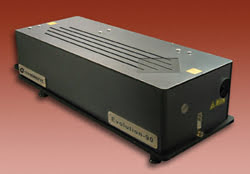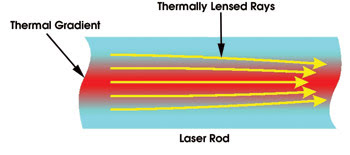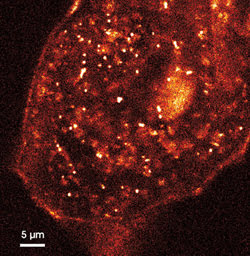Newly commercialized solid-state pump lasers offer great promise in Ti:sapphire systems but require some system design changes, especially in the area of thermal lensing, to realize their full potential.
Marco Arrigoni, Coherent Inc.
Ti:sapphire laser oscillators and amplifiers are the dominant sources for ultrafast applications because they can deliver ultrashort (<100 fs), widely tunable pulses and high pulse energies at various repetition rates. No other active medium, either available now or on the horizon, can match their performance.
Frequency-doubled, diode-pumped, solid-state green lasers are essential components in any Ti:sapphire ultrafast system. CW versions pump both the oscillators and high-repetition-rate (>50 kHz) regenerative amplifiers, and Q-switched models pump regenerative and/or multipass amplifiers that deliver high pulse energies.
Recent technical advances have raised the maximum output power of both pump laser types, with commercial devices providing 90 W at 10 kHz for Q-switched lasers and 18 W (single frequency) for CW lasers. These pump power levels address virtually all practical Ti:sapphire applications and — in the case of CW pumps — match the high-power performance previously available only from ion lasers.
As a result, we can expect positive implications for application areas from spectroscopy through materials processing. However, to fully deliver on this potential will require careful redesign of Ti:sapphire laser systems to address some key issues, most notably thermal lensing.
Pumped up
A typical pump laser for an ultrafast oscillator is a frequency-doubled, diode-pumped Nd:YVO4 with CW output at 532 nm. These lasers feature low-noise, TEM00 output beams that can be intracavity doubled (from 1064 to 532 nm) with high efficiency. Thus, the laser’s pump diodes can operate at de-rated levels for very long lifetimes.
Until recently, this type of green laser provided output powers of 10 W or less. However, newer high-power pump diodes and high-efficiency doubling options have produced output powers of 18 W and beyond, with the same low-noise, single-frequency operation, TEM00 output and small footprint.
An ultrafast regenerative or multipass amplifier achieves high-energy pulses by amplifying the mode-locked output of an oscillator. These amplifiers are typically pumped by a Q-switched, frequency-doubled Nd:YLF laser with output at 527 nm. In Q-switched applications, Nd:YLF has a longer upper-state lifetime than Nd:YAG and Nd:YVO4. Thus, the laser crystal can store more energy and deliver higher pulse energies at the 1- to 10-kHz repetition rates most commonly used with a Ti:sapphire amplifier. Also, Nd:YLF exhibits a relatively low degree of thermal lensing, simplifying cavity design.

Figure 1. Technical advances have raised the maximum output power of both CW and Q-switched green lasers for pumping Ti:sapphire systems. This compact Nd:YLF Q-switched laser delivers 90 W at 10 kHz.
Until recently, commercial Nd:YLF pump lasers offered a maximum output of around 30 W, resulting in Ti:sapphire amplifier powers of 3 W, achieved by diode-pumping a single Nd:YLF rod. However, new designs enable two rods in a tandem cavity to produce 90 W of green output within the same small footprint (Figure 1). How can 30 plus 30 equal 90? Several factors are involved, but most importantly, using two rods in a tandem cavity doubles the cavity gain with virtually no increase in loss.
High-power CW pumping
For Ti:sapphire applications, the advent of 18-W CW pump lasers will have four advantages:
• One oscillator can be pumped at higher power levels. This would be useful for applications in semiconductor research (e.g., solar cells) where higher power levels can improve experimental signal-to-noise ratios and lower data acquisition times. Furthermore, a Ti:sapphire oscillator is often used with a synchronously pumped optical parametric oscillator (OPO) to gain wide tunability, particularly in the mid-IR. Because optical parametric conversion is a nonlinear process, boosting the Ti:sapphire output can greatly increase OPO output power.

Figure 2. The energy from the pump beam leads to a radial thermal gradient in the laser rod, causing thermal lensing. Because the refractive index of Ti:sapphire increases with temperature, the rod acts as a positive lens, focusing the laser beam.
The main issue in pumping a single oscillator with 18 W is thermal lensing in the Ti:sapphire crystal. Thermal lensing is an axial refractive index gradient produced by heating (Figure 2), which results from absorption of the pump beam. This makes the crystal act as a positive lens. For example, a pump power of 10 W and a beam waist of 50 μm produce a lens of more than 50 diopters. This effect is usually accommodated in commercial lasers by changing the focal length of the cavity mirrors.
Clearly, this thermal lensing will get even stronger at higher pump powers. Many tricks can be employed to design a cavity around a strong thermal lens, such as distributing the lens over multiple crystals or longer crystals, but all of them involve compromise in the overall design. Furthermore, any design compensating for thermal lensing will work well with only one consistent pump power.
• One pump laser can operate two oscillators, even at “difficult” wavelengths at the extreme ends of the tuning range. Experiments such as four-wave mixing (e.g., coherent anti-Stokes Raman spectroscopy) sometimes need two Ti:sapphire ultrafast lasers (Figure 3). An optional timing/locking mechanism can be used to synchronize the lasers.

Figure 3. This coherent anti-Stokes Raman spectroscopy microscope image of an epithelial cell was obtained by tuning two lasers to excite the aliphatic C-H stretch band, which highlights mostly lipids in this case. Courtesy of Eric Potma and Sunney Xie, Harvard University.
For a variety of subtle reasons relating to mode noise, this synchronization is tighter on a pulse-by-pulse basis when both lasers use the same pump. One 10-W laser could pump two typical commercial oscillators, but limitations can arise when operating these lasers at certain wavelengths — i.e., at the edges of their gain bandwidth, beyond 1050 nm — or when multiple nonlinear processes are required to reach the final wavelength(s). These limitations disappear when 18 W of pump power is available.
• One laser can pump both a Ti:sapphire oscillator and a high-repetition-rate regenerative amplifier at power levels formerly requiring separate pump lasers. This type of amplifier generates pulse energies in the microjoule range at repetition rates of 250 kHz and beyond. Such repetition rates (up to 50 times higher than pulsed-pumped ultrafast amplifiers) are useful in applications where a large number of data points must be collected in a short time, or for signal averaging at low signal levels. These high pulse repetition rates are also of interest in a number of emerging micromachining applications, where the scale of the features being machined requires only nanojoule or microjoule pulses but a high throughput.
Using one 18-W laser to pump both the oscillator and the amplifier (vs., say, combining one 5-W and one 10-W laser) simplifies the system, reduces its total footprint and minimizes its overall cost, without compromising the final output power.
• A high-repetition-rate amplifier can be operated at even higher repetition rates — up to 1 MHz — or high pulse energy at the same repetition rate. No other commercial laser device can achieve this combination of high repetition rate, microjoule pulse energies and ultrashort pulse duration.
Pumping the Ti:sapphire crystal at higher powers means that each round trip in the amplifier cavity provides higher gain. Therefore, amplification to the microjoule pulse energy level requires fewer round trips, which in turn allows the amplifier to operate at a higher repetition rate. Alternatively, at lower repetition rates, the higher gain leads to higher output pulse energies.
Of course, the issue of thermal lensing applies also to the CW-pumped amplifier. If necessary, however, the system can be redesigned with multiple compensating lenses, because the peak power level is not sufficient to lead to air breakdown at expected focal lengths.
Q-switched pumping issues
The high pump power issues in Ti:sapphire oscillators and CW amplifiers pale in comparison with those in high-energy amplifiers pumped by Q-switched green lasers at 1 to 10 kHz. With 90 W of pump power, this type of amplifier can deliver up to 10 W of output, instead of the 3 W formerly available. (The pulse energy depends on the pulse repetition rate: At 1 kHz, it would be 10 mJ.)
Again, the main problem is thermal lensing. The stronger the thermal lens, the more difficult the design of a regenerative amplifier cavity that is long enough to accommodate switch in/out and is large enough to provide mode volume for efficient energy extraction. To use the new generation of high-power pump lasers, amplifier designers will have to create exotic cavity designs or use enhanced cooling techniques to mitigate the thermal lens.
Efficiently cooling the entire bulk of the crystal can greatly reduce thermal lensing. In commercial amplifiers, a Peltier cooler works with a circulator and chiller to yield a crystal surface temperature of around 0 °C. This arrangement can manage the problem below 30 W of pump power but not at 90 W.
Ti:sapphire’s thermal conductivity and thermo-optical properties can be used to solve the problem through cryogenic cooling. The thermal conductivity increases dramatically at cryogenic temperatures, from 0.26 W/cm K–1 at 300 K to 9.8 W/cm K–1 at 77 K. Thus, a given pump energy produces a much weaker thermal gradient at 77 K. Also, the dependence of the refractive index on temperature decreases at lower temperatures: dn/dT is 1.3 × 10–5/K at 300 K but only 1.8 × 10–6/K at 77 K. The result of these effects is that a Ti:sapphire crystal cooled to a temperature of 77 K has about 500 times less thermal lens power than one at 300 K.
A number of homebuilt and custom-manufactured, high-energy amplifiers use cryogenic cooling. However, the advent of compact, turnkey lasers with 90 W of green output should spur the development of commercial regenerative and multipass amplifiers that can use this high output power. At this time, it seems unlikely that these will operate successfully without cryogenic cooling.
Meet the authors
Marco Arrigoni is director of marketing with Coherent Inc. in Sunnyvale, Calif.; e-mail: [email protected].